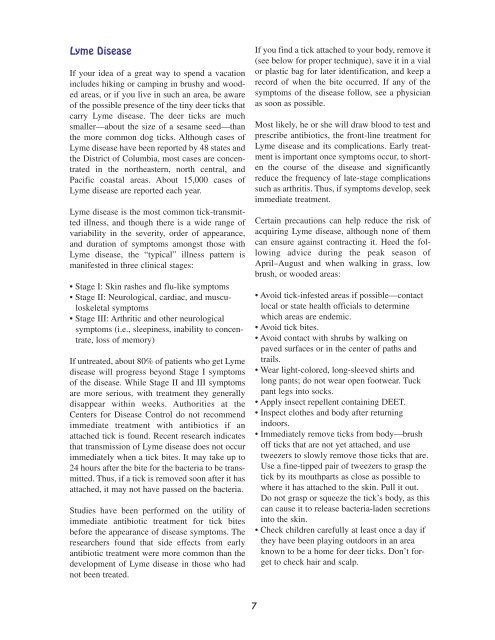View pdf - American Council on Science and Health
View pdf - American Council on Science and Health
View pdf - American Council on Science and Health
You also want an ePaper? Increase the reach of your titles
YUMPU automatically turns print PDFs into web optimized ePapers that Google loves.
Lyme Disease<br />
If your idea of a great way to spend a vacati<strong>on</strong><br />
includes hiking or camping in brushy <strong>and</strong> wooded<br />
areas, or if you live in such an area, be aware<br />
of the possible presence of the tiny deer ticks that<br />
carry Lyme disease. The deer ticks are much<br />
smaller—about the size of a sesame seed—than<br />
the more comm<strong>on</strong> dog ticks. Although cases of<br />
Lyme disease have been reported by 48 states <strong>and</strong><br />
the District of Columbia, most cases are c<strong>on</strong>centrated<br />
in the northeastern, north central, <strong>and</strong><br />
Pacific coastal areas. About 15,000 cases of<br />
Lyme disease are reported each year.<br />
Lyme disease is the most comm<strong>on</strong> tick-transmitted<br />
illness, <strong>and</strong> though there is a wide range of<br />
variability in the severity, order of appearance,<br />
<strong>and</strong> durati<strong>on</strong> of symptoms am<strong>on</strong>gst those with<br />
Lyme disease, the “typical” illness pattern is<br />
manifested in three clinical stages:<br />
• Stage I: Skin rashes <strong>and</strong> flu-like symptoms<br />
• Stage II: Neurological, cardiac, <strong>and</strong> musculoskeletal<br />
symptoms<br />
• Stage III: Arthritic <strong>and</strong> other neurological<br />
symptoms (i.e., sleepiness, inability to c<strong>on</strong>centrate,<br />
loss of memory)<br />
If untreated, about 80% of patients who get Lyme<br />
disease will progress bey<strong>on</strong>d Stage I symptoms<br />
of the disease. While Stage II <strong>and</strong> III symptoms<br />
are more serious, with treatment they generally<br />
disappear within weeks. Authorities at the<br />
Centers for Disease C<strong>on</strong>trol do not recommend<br />
immediate treatment with antibiotics if an<br />
attached tick is found. Recent research indicates<br />
that transmissi<strong>on</strong> of Lyme disease does not occur<br />
immediately when a tick bites. It may take up to<br />
24 hours after the bite for the bacteria to be transmitted.<br />
Thus, if a tick is removed so<strong>on</strong> after it has<br />
attached, it may not have passed <strong>on</strong> the bacteria.<br />
Studies have been performed <strong>on</strong> the utility of<br />
immediate antibiotic treatment for tick bites<br />
before the appearance of disease symptoms. The<br />
researchers found that side effects from early<br />
antibiotic treatment were more comm<strong>on</strong> than the<br />
development of Lyme disease in those who had<br />
not been treated.<br />
If you find a tick attached to your body, remove it<br />
(see below for proper technique), save it in a vial<br />
or plastic bag for later identificati<strong>on</strong>, <strong>and</strong> keep a<br />
record of when the bite occurred. If any of the<br />
symptoms of the disease follow, see a physician<br />
as so<strong>on</strong> as possible.<br />
Most likely, he or she will draw blood to test <strong>and</strong><br />
prescribe antibiotics, the fr<strong>on</strong>t-line treatment for<br />
Lyme disease <strong>and</strong> its complicati<strong>on</strong>s. Early treatment<br />
is important <strong>on</strong>ce symptoms occur, to shorten<br />
the course of the disease <strong>and</strong> significantly<br />
reduce the frequency of late-stage complicati<strong>on</strong>s<br />
such as arthritis. Thus, if symptoms develop, seek<br />
immediate treatment.<br />
Certain precauti<strong>on</strong>s can help reduce the risk of<br />
acquiring Lyme disease, although n<strong>on</strong>e of them<br />
can ensure against c<strong>on</strong>tracting it. Heed the following<br />
advice during the peak seas<strong>on</strong> of<br />
April–August <strong>and</strong> when walking in grass, low<br />
brush, or wooded areas:<br />
• Avoid tick-infested areas if possible—c<strong>on</strong>tact<br />
local or state health officials to determine<br />
which areas are endemic.<br />
• Avoid tick bites.<br />
• Avoid c<strong>on</strong>tact with shrubs by walking <strong>on</strong><br />
paved surfaces or in the center of paths <strong>and</strong><br />
trails.<br />
• Wear light-colored, l<strong>on</strong>g-sleeved shirts <strong>and</strong><br />
l<strong>on</strong>g pants; do not wear open footwear. Tuck<br />
pant legs into socks.<br />
• Apply insect repellent c<strong>on</strong>taining DEET.<br />
• Inspect clothes <strong>and</strong> body after returning<br />
indoors.<br />
• Immediately remove ticks from body—brush<br />
off ticks that are not yet attached, <strong>and</strong> use<br />
tweezers to slowly remove those ticks that are.<br />
Use a fine-tipped pair of tweezers to grasp the<br />
tick by its mouthparts as close as possible to<br />
where it has attached to the skin. Pull it out.<br />
Do not grasp or squeeze the tick’s body, as this<br />
can cause it to release bacteria-laden secreti<strong>on</strong>s<br />
into the skin.<br />
• Check children carefully at least <strong>on</strong>ce a day if<br />
they have been playing outdoors in an area<br />
known to be a home for deer ticks. D<strong>on</strong>’t forget<br />
to check hair <strong>and</strong> scalp.<br />
7










